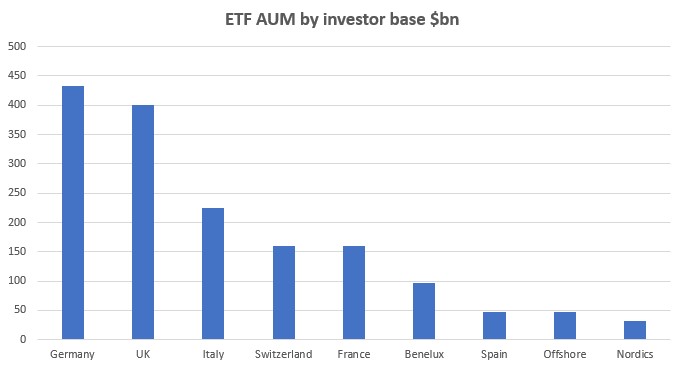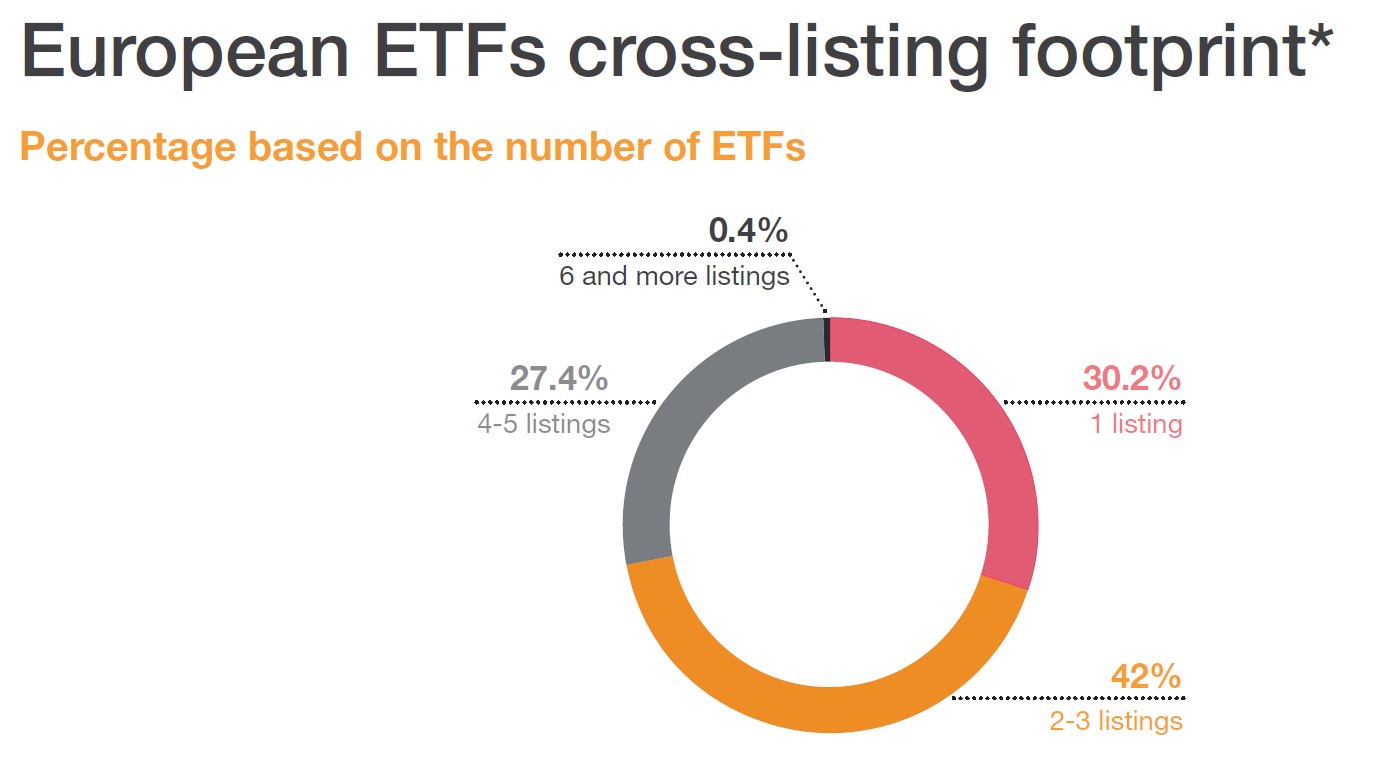Europe is home to some of the major players in the ETF industry and the past few years have brought a healthy level of growth for the wrapper, however, investor appetite, particularly from the retail market, remains relatively subdued.
Last year, ETF flows posted another bumper year across the continent as net inflows hit $195.3bn – a significant increase on the $113bn recorded in 2020 – while assets under management (AUM) topped $1.6trn.
Germany, in particular, experienced growth at a substantial rate, becoming the largest market in terms of ETF investors, with a market share of 27% ($432bn), according to research by Blackwater Search and Advisory, ahead of the UK ($400bn) and Italy ($224bn).

Source: Blackwater Search and Advisory
Tipped as the next US in terms of its ETF growth potential, Germany has caught light on the low-cost, transparent and easy-to-understand ETF savings plans which saw its investment base more than double to three million in 2021.
While countries across Europe have benefitted from some of the same growth tailwinds as Germany over the past two years – the pandemic driven rise in do-it-yourself (DIY) investing and interest in ESG – a fragmented market, a lack of consumer awareness and lack of similar savings plans are holding other areas back.
“The education has not been there across Europe and people just do not understand ETFs while financial advice led market is not playing fair and showing investors the full deck of what they can invest in,” Michael O’Riordan, founding partner at Blackwater Search and Advisory, said. “In Germany, the savings plans mean investors are forced to take more ownership themselves.”
Lay of the land
Despite being the second-largest ETF market in Europe, the UK is largely driven by the private banking space, according to O’Riordan. Home to JP Morgan Private Bank – one of the largest ETF buyers in Europe – much of the UK ETF market is fuelled by these institutions.
Furthermore, initiatives such as the Retail Distribution Review (RDR), first established in 2012 have not moved the dial on retail investing as much as was anticipated.
Caroline Baron, head of ETF Distribution for EMEA at Franklin Templeton, said: “Post-RDR, the industry thought retail adoption would increase. That it was going to be like the US where the market is 50% retail. The bottom line is the market has grown but not massively.”
Other countries such as Spain actively disincentivise ETFs through tax penalties for switching into an ETF that does not exist for mutual funds.
“It is a clear disincentive to invest in an ETF and that was the result of lobbying by the mutual fund industry in Spain,” O’Riordan said. “Spain is a market where everything is distributed by the big banks. The establishment in the asset management industry has tried to introduce tactics to keep ETF vehicles in their box.”
He added investments in Spain are still primarily made by going to visit high street bank branches, a picture that is “pretty similar across Europe”.
In France, the retail market remains subdued and while no ETF savings plan exists similar to Germany, they do have life insurance plans through which individuals can choose to save into an ETF.
Italy seems to have the converse problem. The retail market, which accounted for 21% of trades in 2021, according to figures from Borsa Italiana, is bigger and slightly more established with prominent robo-advisers such as Moneyfarm offering access to a range of ETFs, however, the market is pushing for more institutional demand.
Silvia Bosoni, head of ETFs, ETPs and open-end funds at Borsa Italiana, said: “In Italy, retail was in place at the very beginning. 2020 was a big push for institutional investors to understand ETFs and what they deliver.”
Market hurdles
One of the biggest problems facing Europe more broadly is education, O’Riordan said.
“The level of education at the retail level is shockingly inadequate,” he said. “Most people have never even heard of the term ETF never mind mutual funds. They are completely reliant on their bank manager.
“If people knew what they had available they could take more ownership for themselves.”
Brieuc Louchard, head of ETFs at Euronext, said a big reason the European retail market was struggling was because of market fragmentation.
He said: “The fact that one ETF is listed on five different markets is one of the main issues. This leads to fragmentation of market maker quotes and the spread of liquidity.
“Any move towards a more concentrated market with more volume traded on exchange compared institutional would lead to more liquidity, better spread and will encourage more retail participation.”

Source: PwC, end of June 2021
Baron said the UK has done a little bit in the way of ETF education but there is further to go.
“A lot of things need to change in Europe before you see a massive adoption in retail,” she said. “Platforms in the UK are still pretty old-fashioned in some respects and many of them cannot cater for ETFs, so the adoption has been slower than anticipated.
“There is a train in motion there but contrary to what ETF providers thought many moons ago it has been much slower.”
O’Riordan agreed that ETF uptake across Europe will be a generational shift as opposed to an overnight hit.
He said: “It will take generations to change. As the younger generation gets more comfortable investing the technology makes it more feasible, that is where the real change will come.
“If you are depending on governments to change the structural pension procedure that is going to take forever.”
Green shoots of growth
Just as in Germany, the pandemic had a significant impact on the number of retail investors trading the market which gives the industry reasons to the optimistic.
According to Euronext, around 5-6% of average daily trading across six exchanges was from retail investors in the five years before 2020, which increased to 14-15% in 2020.
Louchard said: “What is interesting is that it stayed at that level for the whole of 2021. We talked with a big retailer broker and some online retail brokers and they both said they succeeded to gain new clients due to people being at home.
“It was clear that an ETF was one of the most successful vehicles because you understand what you are doing in terms of exposure.”
He added French retail investors are starting to use ETFs more and more in their life insurance plans, but that it remains at a low level.
Baron said she can see the growth of retail platforms in Germany filter into the rest of the continent, while more independent financial advisers can improve the education of the product.
“Platforms are busy, we are working quite a lot with a few platform chairs in Germany and we do see a change there which is going to last and increase. Therefore, I hope this will also to the rest of the countries,” she said.
“If I look at Italy, we see more and more independent financial advisers who are turning to us to learn more. They are keen to push the story because they are agnostic.”
Louchard added: “For retail, ETFs are moving at a much slower pace but gently growing. When we discuss it with the big European issuers, the heart of their strategy is how to penetrate retail even more.”
Related articles








